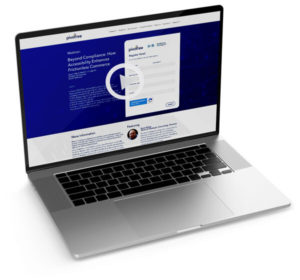Web accessibility solutions have never been more relevant and important to eCommerce business operations. With consumers increasingly shifting to online commerce —and an increase of legal and regulatory activity within the industry — today’s brands must adapt accordingly, with eCommerce website accessibility, to stay competitive, support inclusivity, and remain compliant.
Kris Rivenburgh, Chief Accessibility & Legal Officer at eSSENTIAL Accessibility, and Sean Daley, Head of Strategic Consulting for Pivotree, recently hosted a webinar to discuss crucial aspects of digital accessibility compliance and strategy (you can download the recording below). In this article, we’re passing along the key points to keep the discussion going.
What is eCommerce Website Accessibility?
First, let’s define digital accessibility: the practice of making digital content and services accessible to everyone, including those with disabilities.
Included under that umbrella is web accessibility, which focuses on making web content — including websites and apps — more accessible to people with a wide range of disabilities, including visual, auditory, physical, speech, cognitive, language, learning, and neurological.
Why is eCommerce Website Accessibility Growing in Importance?
Estimates vary, but roughly 15% of the population lives with a disability. And, so much of our world — commerce and otherwise — is shifting online. Without web accessibility, your business faces several risks.
First, you may exclude people from accessing your products and services (and cause strain to those with disabilities in the process). There are real-life implications to a lack of accessibility, and this effect has only been compounded during COVID-19. For example, it’s critical that online tasks such as buying a face mask, filling a prescription, and ordering necessities be made accessible for all.
Second, there are various laws and directives to consider. Compliance with the Americans with Disabilities Act (ADA) and the Web Content Accessibility Guidelines (WCAG), for example, are crucial to avoid opening yourself up to lawsuits. Although web accessibility was not included in the Americans with Disabilities Act at its inception in 1990, most court rulings have interpreted digital assets to fall under the umbrella of enforceable services.
Finally, your brand should be doing its part to eliminate barriers to access through proper site functionality and usability. And even if your site is technically and legally compliant, poor user experience should still be addressed. No one wants to use a cumbersome website that creates unnecessary friction, and the brands with a seamless user experience will win out every time.
How Can You Adapt Digital Accessibility for eCommerce?
There are many actions you should take to improve the digital accessibility of your eCommerce site or platform, including:
- Evaluate third-party integrations.
- Add alt text values.
- Caption all videos.
- Utilize a readable font.
- Ensure the site is keyboard navigable.
- Turn on autofill form capability.
Also, brands should focus on enhancing their overall user experience through better descriptions, improved functionality, faster responsiveness, and mobile optimization.
Automated scans can also be a helpful tool to identify accessibility issues, although this is often a partial solution that requires follow-up with manual inspection.
Avoid cheap and ineffective plug-ins or widgets (typically called overlays) that promise to instantly improve accessibility but fail to deliver meaningful results.
How Can Adopting Web Accessibility Help Your Business?
Removing the risk of non-compliance is a key benefit of pursuing web accessibility. Keep in mind that true accessibility through Web Content Accessibility Guidelines (WCAG) conformance is not instant and requires continuous effort. But, it is the only way to ensure full legal compliance while protecting your site’s privacy and security. The best practice is to proactively make your digital assets in conformance with WCAG 2.1 AA guidelines.
Beyond simple compliance, improving your web accessibility has a whole host of organizational benefits. It widens your pool of customers, increases conversions, offers a better user experience across the board, supports inclusivity, and contributes to the overall positive reputation of your brand.
How Should Digital Accessibility Affect Your Strategy?
Successful implementation of digital accessibility should include not just end-users, but also internal employees, suppliers, retail partners, and all other consumers.
Holistic integration of every process is critical to creating a seamless experience with accessibility at all touchpoints. Every area of your digital capabilities matters — from product data to customer service — and accessibility should be included in every layer of the customer experience journey.
What Resources are Available to Help?
The impact of COVID-19 on consumer expectations has caused many companies to fast-track their eCommerce strategies in 2021. Ideas or programs that may have taken another 5-10 years to see widespread adoption quickly became mainstream overnight. eCommerce frameworks have grown exponentially to keep up with this increased demand, but unfortunately, these capabilities were not always built with the entire customer base in mind. eCommerce website accessibility is one of those areas.
Pivotree and eSSENTIAL Accessibility have partnered to help.
Pivotree designs and manages eCommerce systems for many key players across the industry. Our dedicated experts are committed to guiding customers along their digital transformation journey while developing and leveraging Frictionless Commerce frameworks to drive measurable ROI.
eSSENTIAL Accessibility is a comprehensive digital accessibility-as-a-service platform designed to help organizations create inclusive digital experiences.
We are working together to provide holistic accessibility solutions from site assessment and risk mitigation to remediation and program management.
Ready to Learn More?
In the full session, Kris covers specific examples of barriers to access, more information about the legal landscape of digital accessibility in the U.S., and best practices for conformance.
In addition, Sean details the user experience pathway breaks down the nine organizational capability groups and elaborates on how to build a user journey that addresses the needs of all consumers.
Download the recording of the Beyond Compliance: How Accessibility Enhances Frictionless Commerce webinar below!
[hubspot type=form portal=239143 id=edb41b09-5583-47a2-94e9-d31e98af6c0f]


